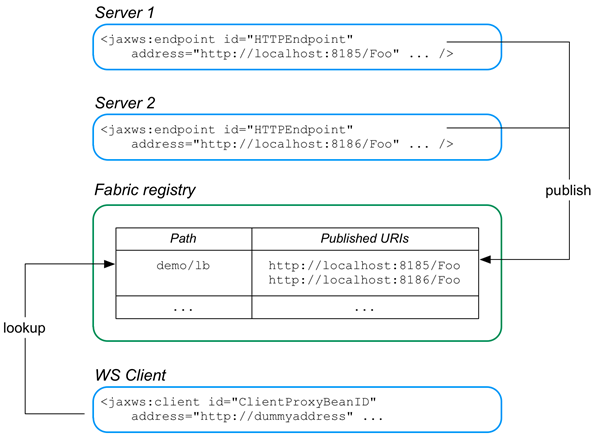Sticking with the recent CXF themes of this blog in this 2 part series we will explore the combination of CXF http endpoints and Fuse Fabric for autodiscovery and load balancing.
One of the advantages of using Fuse Fabric is the autodiscovery of services within the Fabric. In this two part post we are going to take a look at the load balancing feature provided by Fabric for CXF endpoints. Note, it is also possible to use similar kind of features for plain http endpoints. In the first part we will focus on the server side and setup a CXF service in Fuse to use the load balancing feature provided by Fabric. In the second part we will focus on the client side of consuming the load balanced service and execute the lookup in the Fabric registry.
When using the Fuse Fabric load balancing feature, Fabric will provide the load balancing by discovering CXF endpoints and load balancing requests between these endpoints. However, for endpoints to be discovered by Fabric they have to register themselves in the Fabric registry implemented by Apache ZooKeeper. It is worth to note that when an endpoint is registered in the Fabric it is still possible to call that endpoint with the registered address without the Fabric load balancer. The advantage of enabling a Fabric load balancer is that CXF(RS) services can be looked up in the Fabric registry so scaling to new machines can be done without reconfiguring IP and ports on the client side. However for this to work a client also has to use fabric for the ability to lookup endpoints in the Fabric registry. Since the Fabric registry is only available for clients within the Fabric and not for external (non Fuse Fabric clients), this will be the focus of part 2.
 In the picture above from the Red Hat documentation (https://access.redhat.com/documentation/en-US/Red_Hat_JBoss_Fuse/6.1/html/Apache_CXF_Development_Guide/FabricHA.html ) the servers (1 and 2) register their endpoints in the Fabric registry under the fabric path (explained below) “demo/lb”. The client performs a lookup to the same “demo/lb” fabric path to obtain the actual endpoints of the service it wants to call. In the design time configuration a dummy address is configured (http://dummyaddress) this address is not used during runtime, since the endpoints are retrieved from the fabric registry.
In the picture above from the Red Hat documentation (https://access.redhat.com/documentation/en-US/Red_Hat_JBoss_Fuse/6.1/html/Apache_CXF_Development_Guide/FabricHA.html ) the servers (1 and 2) register their endpoints in the Fabric registry under the fabric path (explained below) “demo/lb”. The client performs a lookup to the same “demo/lb” fabric path to obtain the actual endpoints of the service it wants to call. In the design time configuration a dummy address is configured (http://dummyaddress) this address is not used during runtime, since the endpoints are retrieved from the fabric registry.
CXFRS service
For this post a very simple CXFRS service is created exposing one GET method which responds with a fixed string. The interface class of the service looks like this:
package nl.rubix.cxf.fabric.ha.test;
import javax.ws.rs.GET;
import javax.ws.rs.Path;
import javax.ws.rs.PathParam;
import javax.ws.rs.Produces;
import javax.ws.rs.core.MediaType;
@Path("/")
public class Endpoint {
@GET
@Path("/test/{id}")
@Produces(MediaType.APPLICATION_JSON)
public String getAssets(@PathParam("id") String id){
return null;
}
}
The Blueprint context implementing the CXFRS service looks like this:
<?xml version="1.0" encoding="UTF-8"?>
<blueprint xmlns="http://www.osgi.org/xmlns/blueprint/v1.0.0"
xmlns:camel="http://camel.apache.org/schema/blueprint"
xmlns:xsi="http://www.w3.org/2001/XMLSchema-instance"
xmlns:cxf="http://camel.apache.org/schema/blueprint/cxf"
xmlns:cm="http://aries.apache.org/blueprint/xmlns/blueprint-cm/v1.0.0"
xsi:schemaLocation="http://www.osgi.org/xmlns/blueprint/v1.0.0 http://www.osgi.org/xmlns/blueprint/v1.0.0/blueprint.xsd
http://camel.apache.org/schema/blueprint http://camel.apache.org/schema/blueprint/camel-blueprint.xsd">
<camelContext id="blueprintContext" trace="false" xmlns="http://camel.apache.org/schema/blueprint">
<route id="cxfrsServerTest">
<from uri="cxfrs:bean:rsServer?bindingStyle=SimpleConsumer"/>
<log message="The id contains ${header.id}!!"/>
<setBody>
<constant>this is a response</constant>
</setBody>
</route>
</camelContext>
<cxf:rsServer id="rsServer" address="http://localhost:2345/testendpoint" serviceClass="nl.rubix.cxf.fabric.ha.test.Endpoint" loggingFeatureEnabled="true" />
</blueprint>
Note, this service is just plain CXFRS and Camel, no Fabric features have been added yet.
Implementing the load balancer features
To implement Fabric load balancing on the server side the pom has to be updated with extra dependencies and the Blueprint xml file needs to be configured with the load balancer.
The pom needs to be updated with the following items:
Add the fabric-cxf dependency to the pom:
<dependency> <groupId>io.fabric8</groupId> <artifactId>fabric-cxf</artifactId> <version>1.0.0.redhat-379</version> <type>bundle</type> </dependency>
Add the io.fabric8.cxf to the import package of the OSGi bundle:
<plugin> <groupId>org.apache.felix</groupId> <artifactId>maven-bundle-plugin</artifactId> <version>2.3.7</version> <extensions>true</extensions> <configuration> <instructions> <Bundle-SymbolicName>cxf-fabric-ha-test</Bundle-SymbolicName> <Private-Package>test.cxf.fabric.ha.test.*</Private-Package> <Import-Package>*,io.fabric8.cxf</Import-Package> </instructions> </configuration> </plugin>
To add the CXF Fabric load balancer to the Blueprint xml file:
Add the cxf-core namespace to the Blueprint xml:
xmlns:cxf-core=”http://cxf.apache.org/blueprint/core”
Add an OSGi reference to the CuratorFramework OSGi service[1]:
[1] The CuratorFramework service is for communicating with the Apache Zookeeper registry used by Fabric.
<reference id="curator" interface="org.apache.curator.framework.CuratorFramework" />
Instantiate the FabricLoadBalancerFeature bean:
<bean id="fabricLoadBalancerFeature" class="io.fabric8.cxf.FabricLoadBalancerFeature"> <property name="curator" ref="curator" /> <property name="fabricPath" value="cxf/endpoints" /> </bean>
The curator property is a reference to the curator OSGi service reference declared earlier. The fabricPath is the location in the Fabric (Zookeeper) registry where the CXF endpoints are stored. This location in the registry is used by clients to lookup available endpoints. In the picture above this was set to demo/lb
To register the Fabric load balancer with the CXF service add a CXF bus with a reference to the fabricLoadBalancerFeature bean declared above:
<cxf-core:bus> <cxf-core:features> <cxf-core:logging /> <ref component-id="fabricLoadBalancerFeature" /> </cxf-core:features> </cxf-core:bus>
The entire Blueprint xml for the load balancer looks like this:
<?xml version="1.0" encoding="UTF-8"?>
<blueprint xmlns="http://www.osgi.org/xmlns/blueprint/v1.0.0"
xmlns:camel="http://camel.apache.org/schema/blueprint"
xmlns:xsi="http://www.w3.org/2001/XMLSchema-instance"
xmlns:cxf="http://camel.apache.org/schema/blueprint/cxf"
xmlns:cxf-core="http://cxf.apache.org/blueprint/core"
xmlns:cm="http://aries.apache.org/blueprint/xmlns/blueprint-cm/v1.0.0"
xsi:schemaLocation="http://www.osgi.org/xmlns/blueprint/v1.0.0 http://www.osgi.org/xmlns/blueprint/v1.0.0/blueprint.xsd
http://camel.apache.org/schema/blueprint http://camel.apache.org/schema/blueprint/camel-blueprint.xsd">
<camelContext id="blueprintContext" trace="false" xmlns="http://camel.apache.org/schema/blueprint">
<route id="cxfrsServerTest">
<from uri="cxfrs:bean:rsServer?bindingStyle=SimpleConsumer"/>
<log message="The id contains ${header.id}!!"/>
<setBody>
<constant>this is a response</constant>
</setBody>
</route>
</camelContext>
<cxf:rsServer id="rsServer" address="http://localhost:2345/testendpoint" serviceClass="nl.rubix.cxf.fabric.ha.test.Endpoint" loggingFeatureEnabled="true" />
<!-- configuration for the Fabric load balancer -->
<reference id="curator" interface="org.apache.curator.framework.CuratorFramework" />
<bean id="fabricLoadBalancerFeature" class="io.fabric8.cxf.FabricLoadBalancerFeature">
<property name="curator" ref="curator" />
<property name="fabricPath" value="cxf/endpoints" />
</bean>
<cxf-core:bus>
<cxf-core:features>
<cxf-core:logging />
<ref component-id="fabricLoadBalancerFeature" />
</cxf-core:features>
</cxf-core:bus>
</blueprint>
When we deploy this service in a Fabric profile on a container we can access the service through the assigned endpoints the container gave us. Note this is not yet using the load balancer feature, since accessing the service through a browser does not perform the lookup in the Fabric registry.
 You can find the endpoint the container assigned to the services on the APIs tab:
You can find the endpoint the container assigned to the services on the APIs tab:
 When we access the endpoint through a browser, again without using the Fabric load balancer we get the response:
When we access the endpoint through a browser, again without using the Fabric load balancer we get the response:
As mentioned above to use the Fabric load balancing on the client side clients have to be able to access the Fabric registry. There are two possibilities to accomplish this:
- Implement a fabric-http-gateway by assigning this profile to a container: http://fabric8.io/gitbook/gateway.html
- Build a Camel proxy
In part 2 we will explore the client side for accessing the Fabric load balancer.
For more information about CXF load balancing using Fabric:






